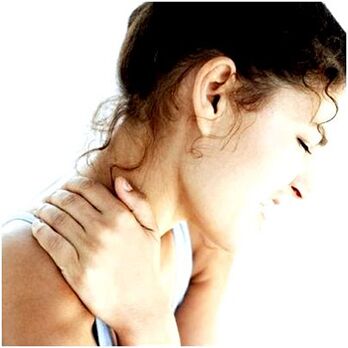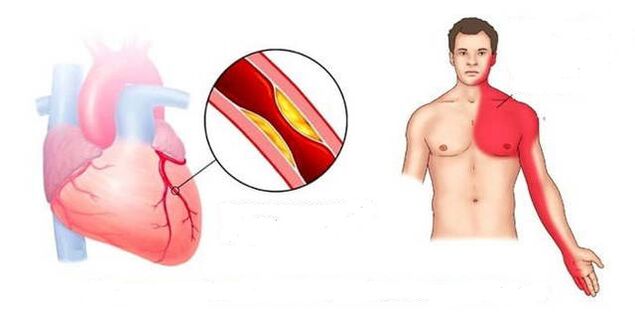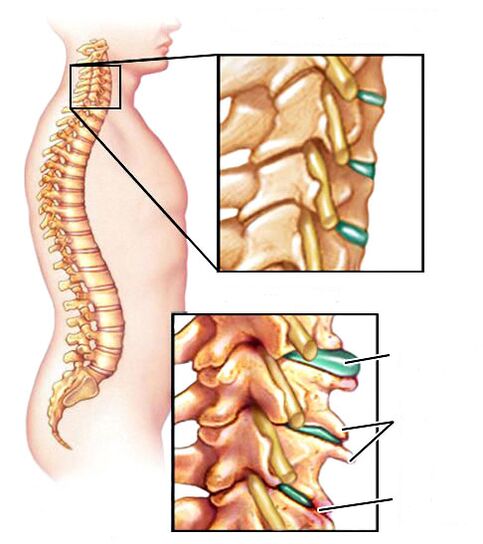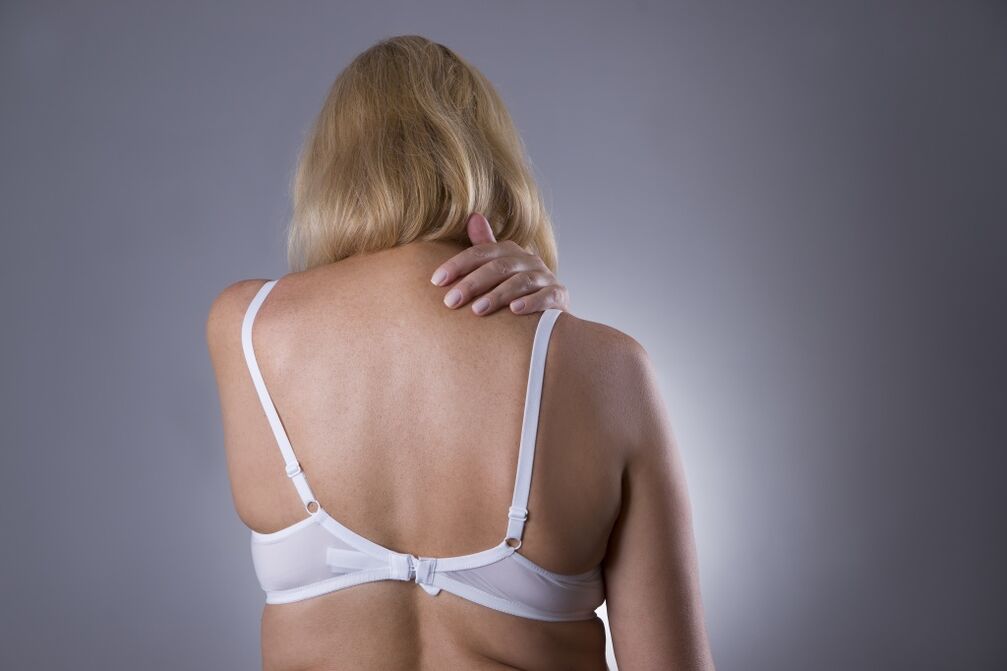
The osteochönig process influences one of the spine or several at the same time.The lumbar and cervical vertebrae are most affected by pathologies that are most susceptible to loads due to the anatomy of the human skeleton.
The consequences of osteochondrosis in the spine in the cervix region cause the greatest inconvenience and potential complications because the neck is an area that is rich in neuromusive motorways, many of which directly feed the brain.
For this reason, clinical symptoms with cervical osteochondrosis are connected to the ischemia of brain areas.In addition, the nerve roots that provide the sensitivity and motor activity of the hands and shoulder girdle, a variety of symptomatic image when pressing with destroyed vertebrates.
Note the general clinic of the osteochondrosis of the cervical spine below.
dizziness
Dizziness is also due to a violation of the blood flow against the organs of the inner ear, which ensures the body's balance.Nystagm often combines dizziness - arbitrary fluctuations in the eye pupils on the sides.
Lack of air
This sensation appears due to the irritation of the ends of the diaphragm.It is part of the nerve beam in the cervix and is involved in the regulation of breathing, its depth and frequency.The patients complain about the inability to breathe in full chest.
In some cases, the symptom exacerbates severe shortness of breath and suffocation.For the same reason, breathing stops at night and snoring.
The disadvantage of oxygen due to breathing problems is ultimately the cause of increased fatigue, a decrease in concentration and memory problem.
Trimming
It is accompanied by the air air.Also due to problems with blood circulation in some areas of the brain and inner ear.Nausea is sometimes observed with indomitable vomiting, which are provoked by movements of the head and body.The consequence of frequent nausea and vomiting is a decrease in appetite, weight loss and digestive failure.
Problems with seeing
"Fly" in the eyes, a decrease in visual acuity, fog in front of the eyes - these are all symptoms due to the ischemia of the brain area responsible for seeing.
Patients with osteochondrosis are less likely to complain because the lack of blood supply is compensated for by the vertebral houses by blood flow from the carbon artery system.
Glasses and therapeutic gymnastics for the eye muscles do not solve the problem, usually seeing improves after the treatment of osteochondrosis.

An unstable level of pressure is due to an impaired blood flow in the long brain, which is responsible for the functions of the vascular motor center.
It occurs with a cramp of the brain's arteries due to the short -term termination of blood flow along the vertebral arteries.
From the condition of the loss of the patient's consciousness, they can be removed quickly by laying it a little higher than the head - the blood flow to the brain enables a person to live to life.
After a fainting, reversible problems with language and movements can be observed for some time due to a short blood flow.
Green symptoms
It can often be the only sign that indicates the cervical osteochondrosis.They are expressed as sweat, dryness and feeling of a clud in the throat and difficulties when swallowing.The symptoms are connected to the compression of the nerve plexus, which is responsible for the innervation of the pharynx.It is necessary to distinguish such manifestations from a similar clinic for inflammation or neoplasms.
The increase in body temperature for cervical osteochondrosis is not the most typical symptom, it is rarely and locally observed: in the cervical and collar area with a slight reddening of the skin.
The osteochondrosis clinic in the cervical spine can initially be different severity of the severity.Even in times of deterioration, they are brighter and second to form in certain syndromes.
Level I
The beginning of the degenerative processes in the cartilage of the vertebral slices.The symptoms are weak, sometimes it cannot be observed at all.The first signs of an osteochondrosis of the cervical spine:
- Complaints in the neck, arms, shoulders, sometimes pain;
- Headache;
- simple restriction of the motor activity of the neck;
- fast temporary visual impairment;
- Reduction of the sensitivity of the skin of the collar area.
Important: These symptoms are more pronounced when tipping the head.
As a rule, the patients do not go to the doctor in the first stage of osteochondrosis of the cervix region, and believe that all symptoms are associated with fatigue, stress, age, lack of sleep.
Level II
At this stage, the vertebrate's lead began, the band fire cracks Schmal, the collagen fiber of the fiber ring of the disc is destroyed.Due to the compression of the nerve trunks, which increases during the neck movements and the copy, there are noticeable painful symptoms of a point in nature.Here you can already suspect the cervical osteochondrosis, the symptoms of which are as follows in the second stage:
- pronounced pain in the neck, sometimes with a crunch;
- The skin of the shoulders and hands almost completely loses sensitivity;
- Headaches are common, do not happen long;
- Visual impairment with "flying" in the eyes;
- Ringing and noise in the ears;
- Weakness of the muscles of the upper extremities;
- The clarity of the tendon reflexes is reduced;
- Pain with dedication under the shoulder blade;
- The feeling of a lump in the throat, problems with swallowing;
- Sleep disorders, usually insomnia.

Holding the head long in a position leads to severe pain.At this stage of the development of the disease, patients are already coming to the doctor to receive help.
Level III
The fibrous ring in the window is destroyed, hernia are formed.In the third stage, due to its weak fixation, there is a deformation of the spine, shift and transfers of the vertebrae.The symptoms are as follows:
- Intensive, acute pain in the neck, collar zone, heart area;
- the sensitivity of the scalp on the back of the head, in the shoulder region, in the hands to complete absence;
- Hernia of the cervical spine;
- Parese and paralysis of the upper extremities;
- Tendular reflexes are practically not observed.
This is a serious stage of the disease in which the patient can no longer support his head himself.The ischemia of the spinal cords and the compression of the spinal arteries lead to paralysis and paresis in other parts of the body and in the spine line.
Non -specific and a large number of different symptoms that accompany the osteochondrosis of the cervical spine, it is difficult to diagnose diagnosis and further treatment, since some of them can be a sign of completely different diseases.Symptoms of cervical osteochondrosis are formed in certain groups called syndromes.Their existence and heaviness can indicate a pathology in the cervical spine with an updated localization.
Clinical image of osteochondrosis of the cervical spine - symptoms, signs
Osteochondrosis of the cervix region is a chronic, slowly progressive spinal disease in which vertebrae, intervertebral discs and slices are affected and destroyed.The vertebrae from the first to the seventh, which belong to the cervix region.

In the course of the disease, the intervertebral discs lose their elasticity and strength, flat, relax, their amortization properties deteriorate.Such a deformation is due to changes caused by performance disorders and tissue raving.
These violations are one of the natural procedures on the age of the body, but various overloads, posture disorders, injuries, congenital anomalies of the spine and some other causes provoke cartilage and slices early.
Pain can have different localization, they can be in the back of the head area in the shoulder or in the upper link in the throat.Pain in the shoulder or hand appear when the vertebral column of the nerve innovates that the upper extremity is involved in the process.The pain in the occipital part of the head is caused by cramps of the neck muscles, which are attached to the occipital bones and the circulatory diseases in this zone.
When symptoms occur:
- A decrease in sensitivity in the hand occurs when a spine is damaged that contains sensitive nerves that innovate the skin of the upper extremity.
- The restriction of movements in the cervical spine and the crispness during the movements is due to a decrease in the height of the intervertebral disc, the occurrence of bone growth on the bodies of the vertebrae and a damage to the small joints between the cervical vertebrae.
- Dizziness, impairment of the coordination, weakness in severe cases occurs in severe cases with a severe deterioration in blood supply to the Occipital proportion of the brain, cerebellar and fuselage.
- Dustiness of the language, acceptance of hearing and vision
All of these symptoms are due to the participation of the vertebral artery in this process, which takes place in its own channel in the cross processes of cervical vertebrae.As a result of the development of cervical osteochondrosis, the formation of fiber tissue, the vertebrae of the vertebrae, blood flow deteriorates in these arteries, which leads to a deterioration in blood supply to blood supply to the hacipital faction of the brain and brain.
Reasons
- excessive physical activity in sport or severe physical work;
- hereditary disposition;
- Humanization of the neck (walking without a scarf in winter);
- Stress;
- Work on the computer;
- Obesity.
Some of the above causes cause osteochondrosis and other spine.
The degree of osteochondrosis is determined by the clinical image and the patient's symptoms.The concept of the degree should not be confused with the stages of osteochondrosis.The phases are discussed below.

Taking into account and analyzing the procedure for the development of changes in the tissue of the vertebrae, the doctors differentiated several stages of osteochondrosis of the cervix region:
- Preclinical phase.The cervical osteochondrosis of the 1st degree is expressed by the shift of the pulpoose core to the side and the beginning of the destruction of the fibrous ring.Pain during this time cannot be present, a small lordosis and difficulties when turning or tilting the head are possible.
- Osteochondrosis of the cervical region of the 2nd degree is characterized by an increase in pathological destruction, the instability of the entire segment with subluxis, and pain sometimes appears in the shoulder strap or in the arm.The patient complains about distraction, a deterioration in memory and attention.
- Osteochondrosis of the 3rd degree develops with a complete break of the fiber ring.Neurological symptoms occur, the sensitivity is disturbed.The pain in the third stage becomes constant and disturbs the patient.The mobility of the neck segment worsens.
- Osteochondrosis of the neck 4 degrees.The last phase of the degenerative process.The intervertebral disc is completely replaced by connective tissue, all symptoms are more pronounced, a deterioration in the coordination of movements, ataxia is determined.
Depending on the localization of pain, the following types of diseases are differentiated: radicuicemia, cervic brachialgia, cervicocranialia and cervicalgia.
According to the method, the disease is of course common to divide into acute intervertebral osteochondrosis of the neck, which appears for the first time and chronic and extends with constant remissions and deterioration for years.
Which doctor treats cervical osteochondrosis?
The variety of symptoms, which often hide under the mask of another disease, leads to a logical question - which doctor can contact?If pain in the neck, shoulders and hands or the occurrence of neurotic disorders, it is urgent to approach the neurologist or vertebrologist.
And who you have to contact if there are no such specialists in the local clinic?In this case, the ticket should be moved to the therapist.The doctor prescribes the treatment or sends a close specialization to the doctor.
Symptoms depending on the damaged vertebrae
Regardless of this, radicular syndromes can be differentiated, which leads to a sensitive and motor disorders.They differ depending on which type of vertebrae the spine root presses:
- C1: leads to deafness and impairment of sensitivity in the back of the head;
- C2: Pain in the Parietal region and in the back of the head;
- C3: Language impairment, sensitivity of language, pain and decrease in sensitivity in the side on which the nerve of the spine is violated;
- C4: Pain in the heart, on the left hypochondrium, in the shoulder, shoulder blade, breathing disorders, decrease in the sound of the neck muscles;
- C5: Pain in the shoulder in the outer area;
- C6: The pain that gives way from the forearm to the thumb of the hand and from the neck on the shoulder blade;
- C7: The pain in the rear surface of the shoulder, from the neck to the shoulder blade, gives the forearm up to 2-4 fingers of the hand;
- C8: Pain from neck to shoulder, from the forearm to little fingers.
Diagnosis of osteochondrosis
In order to make a diagnosis, instrumental examination methods are used:
- X -Ray examination of the spine department;
- Myelography;
- Neurological examination of sensitivity, reflexes.
Additional methods for differentiation and clarification of the diagnosis contain the stage of the pathology:
- Computer tomography of the spine (CT);
- Nuclear-Magnetic Resonance (Jamr);
- Magnetic resonance imaging (MRI).
During the examination with the implementation of neurological tests, the doctor evaluates the degree of mobility and pain of the neck as well as the impaired blood flow in vertebral artery.
The cervical osteochondrosis requires not only the examination of the vertebrae itself, but also near tissues, blood vessels and nerves.Only then can we assess the full image of pathological changes that occurred due to diseases.
The diagnosis of cervical osteochondrosis begins with a visual examination and overview of the patient.The neuropathologist is interested in living and work diseases, the presence of chronic complaints, nutrition and motor activity.
A preliminary diagnosis is confirmed by carrying out instrumental research:
- X -Ray in two projections;
- MRI;
- CT;
- UZDS (duplex scanning).
The analysis of hormones is required for fairer sex.Without them, the treatment of cervical osteochondrosis in women does not begin.
In order to exclude pathologies with such symptoms, a differential diagnosis is carried out with the appointment of additional consultations with a surgeon, gynecologist, cardiologist, ophthalmologist and tradition.
Complications of osteochondrosis
Osteochondrosis of the cervical spine is dangerous with its complications.With the undesirable development of the disease, pressing the arteria on spine can lead to a stroke of a brain that affects a continued deterioration of hearing and vision.
Often an intermediate vertebrae, severe hypertension and numbness or cooling of the fingers with osteochondrosis are followed.In women, complications of neurological nature often develop - constant fatigue, lethargy, loss of performance, excessive resentment.
The non -compliance with the prescribed treatment, a longer avoidance of a doctor and the lack of therapy for osteochondrosis contributes to the progress of the disease and provokes the development of complications, pathologies and new diseases such as:
- Hernia of the intervertebral discs (hernia of the spine);
- Projection;
- Kyphosis;
- Radiculitis;
- Salt deposits in the band room;
- Spinal cords;
- Reduction of muscle mass of limbs, muscle atrophy due to impaired blood supply;
- Paralysis of the lower extremities.
Despite the fact that the 4. degree of osteochondrosis can occur without pronounced symptoms and pain, neglected osteochondrosis is the most dangerous for the development of serious complications and can lead to the patient's disability.
Medical physical education
LFK for cervical osteochondrosis should be carried out outside the acute exacerbation.The greatest effectiveness of this technique during the recreation period.There should be no complaints and pain while implementing the complex!
| Exercise number 1 | Place on your stomach, Luh your hands on the floor, increase your head and upper body, your back should be straight.Stay in this position for 1-2 minutes.Slowly sink to the ground.Repeat 2-3 times. |
| Exercise number 2 | Place on your stomach, stretch your arms on the body, turn your head to the left, try to touch the floor with your ear and then turn your head to the right.Repeat 6-7 times in every direction. |
| Exercise number 3 | Lean forward in a seated position and try to touch your chest with your head, then breathe out, lean back and throw your head.Repeat 10-15 times. |
| Exercise number 4 | When sitting, put your palms on your forehead, put pressure on your palms on your forehead, and your forehead is on your palm.Continue this exercise for 30 seconds.Repeat 2-3 times. |
| Exercise number 5 | Slowly turn your head in one direction and then in the other direction.10 rotations in each direction.Make sure there is no dizziness.When it appears, the exercise stops. |
Risk factors
The chances of maintaining osteochondrosis increase when they:
- Anomalies of the development of the spine;
- Obesity;
- long physical exertion;
- bad habits (smoking);
- sitting lifestyle;
- Work that implies the regular influence of the vibration on the spine (e.g. with drivers of vehicles);
- long stress, excessive nervous tension;
- Local hypothermia;
- Previous injuries in the neck and neck;
- Autoimmunpathologies that include the degeneration of cartilage.
Psychosomatics
The development of cervical osteochondrosis shows the inability to withstand the problems competently.Sometimes people become so strong and confident in their skills that their stability is transformed into rigidness and lack of flexibility.In this case, attempts to turn your head are accompanied by stiffness, cramps and other unpleasant sensations.
In addition, osteochondrosis can develop in people who are afraid of problems and do not know how to deal with them.In this case, the protective reflex of the mammalian is triggered and the head literally pulled into the shoulders.This provision is therefore considered unnatural, so the muscles of the cervix region begin to violate and deform.
Treatment
The treatment of cervical osteochondrosis depends on the stage of the disease.If there is sufficient conservative, hiking treatment in the first stage, then in the second and third stage it is the doctor's task to initially stop pain syndrome.Improved cases may require surgical treatment for decompression and stabilization of vertebrae.
Drugs
| group | Description |
| NSAIDS (non -steroidal anti -inflammatory medication) | Help remove swelling and pain.The basis of the most frequently used medicines are such acting components such as sodium diclofenac. |
| Vasodilative medication | Contribute to improving blood circulation. |
| Seaous aids, muscle relaxants | They are also prescribed to facilitate the general condition of the patient and reduce the doses of the NSAID.At the same time alleviates nervous overcourse and muscle cramps, they help to achieve a better therapeutic effect. |
At the end of the therapy course, the NSAIDs should be bought for a first kit for a house for a house, since the pain in the neck can be returned regularly (with stress, overcap, change of weather).Before you take drugs, contact your doctor.
If a positive effect is not observed after conservative treatment of conservative treatment, the doctor can recommend the patient with Spinal Fussia.
With this procedure you can immobilize the affected spine segment.
Its essence is to remove the intervertebral disc, the decompression of the nerve root, the installation of the implant or the creation of the physiological height of the disc space.
The company has many side effects and contraindications.So it can cause a vertebrogenic disability.Therefore, surgery is carried out in extreme cases.
With the massage with cervical osteochondrosis, you can achieve noticeable improvements.It is important that the procedure is carried out by a specialist: incompetent movements in the area of the cervical spine can make the situation worse.Movements should influence the collar zone, the cervix region and part of the back.
Pay attention to the technique of carrying out exercises to treat cervical osteochondrosam massage for osteochondrosis implies the change of the following actions.
- Stroke.The masseur influences the surface layers of the skin and moves from the head to the upper third of the middle of the back.At the same time, palms or fingertips work.
- Press.Deep layers of skin in the upper third of the back are exposed.In this case, the index and the thumb of the hands are carried out over the neck to take the skin.In addition to the vertebrae, fabrics are not involved in this process.
- Trituration.It is carried out to warm up the skin and increase blood flow in the collar area.The procedure must be carried out extremely carefully.It is forbidden to influence the specialist processes of the vertebrae.Sometimes grating is replaced by circular lines or movements that resemble sawing.
- Knead.It affects deep -lying fabrics, so it has a limited value.It can worsen the pathology.
During the massage, the patient should be on the stomach in extreme cases.
prevention

To prevent the disease, it is recommended:
- For the health of the spine, it is important to sleep on which pillows on an orthopedic pillow and a mattress.
- Take a hot shower for 10 minutes a day;
- Visit a bath house or a sauna (relieves cramps of the neck muscles);
- Avoid sharp tendencies and headlamps;
- Go more on foot, make yoga and swim;
- Make “sitting” work every hour (you have to take breaks, go into different directions with a body and head).
- Avoid an increased load on the spine: classes with weights, jumps, run;
- Choose chairs and chairs that support the spine;
- Add dependencies such as smoking, abuse alcohol abuse;
- Drink at least one and a half liters of water a day.
It is often recommended (at least five times a day) and in small portions when the food is recommended with cervical osteochondrosis.Preferences should be presented or cooked dishes.Salads must be seasoned with olive oil.



























